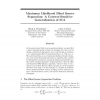Free Online Productivity Tools
i2Speak
i2Symbol
i2OCR
iTex2Img
iWeb2Print
iWeb2Shot
i2Type
iPdf2Split
iPdf2Merge
i2Bopomofo
i2Arabic
i2Style
i2Image
i2PDF
iLatex2Rtf
Sci2ools
112
Voted
NIPS
1996
1996
Maximum Likelihood Blind Source Separation: A Context-Sensitive Generalization of ICA
In the square linear blind source separation problem, one must nd a linear unmixing operator which can detangle the result xi(t) of mixing n unknown independent sources si(t) through an unknown n n mixing matrix A(t) of causal linear lters: xi = P j aij sj. We cast the problem as one of maximum likelihood density estimation, and in that framework introduce an algorithm that searches for independent components using both temporal and spatial cues. We call the resulting algorithm \Contextual ICA," after the (Bell and Sejnowski 1995) Infomax algorithm, which we show to be a special case of cICA. Because cICA can make use of the temporal structure of its input, it is able separate in a number of situations where standard methods cannot, including sources with low kurtosis, colored Gaussian sources, and sources which have Gaussian histograms. 1 The Blind Source Separation Problem Consider a set of n indepent sources s1(t) ::: sn(t). We are given n linearly distorted sensor reading whi...
Blind Source Separation | NIPS 1996 | NIPS 2007 | Source Separation Problem | Unknown Independent Sources |
Related Content
| Added | 02 Nov 2010 |
| Updated | 02 Nov 2010 |
| Type | Conference |
| Year | 1996 |
| Where | NIPS |
| Authors | Barak A. Pearlmutter, Lucas C. Parra |
Comments (0)

